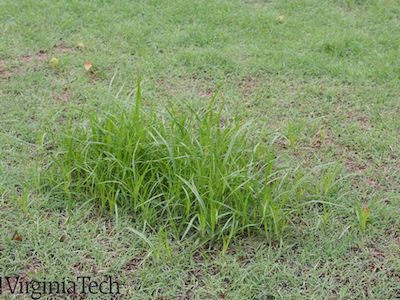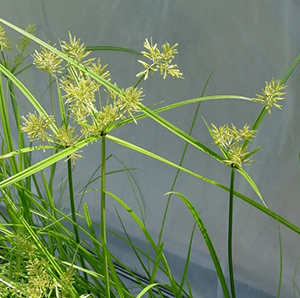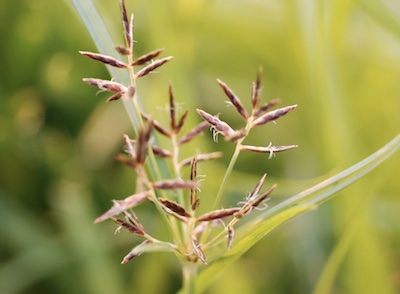Got Nutsedge? Find the Nutlets
By Carolyn R. Casey, Fairfax Master Gardener
Nutsedges are extremely belligerent and unrelenting weeds that may be difficult but not impossible to eliminate. Control involves both cultural and chemical management. They are called “nutgrasses” because they look like grass. They are easily recognized and well known for their triangular stems and the plants’ triangle shape when viewed overhead. They are frequently evidence of inadequately drained soil and successfully compete with turf in just about any condition.

Yellow nutsedge grows taller than surrounding grasses
In Virginia, nutsedges generally appear in June and remain in the turf until frost. They then appear much like warm-season grasses and go into a winter dormancy period. Yellow nutsedge (Cyperus esculentus) has tubers at the end of its rhizomes while the closely related purple nutsedge (Cyperus rotundus) has tubers along its below-ground stem. Nutsedge plants can form patches 10 feet in diameter (3 m).
Yellow nutsedge is the most common sedge problem in Virginia. It appears in the spring and into late summer. It is an upright growing weed that is between 12 to 32 inches tall (30 – 80 cm). It was once cultivated in ancient Egypt for its tasty and oil rich tubers. It is now found on all continents. Yellow nutsedge has flowers that appear as spikelets in the early summer and into the autumn. The flower seed heads look like grass seed heads; they are flat, multi-branched and are yellow brown and form three-sided flower stalks. The yellow flowers appear in clusters. They are flat and 0.5 to 1 inch (1 – 2 cm) in length and form tubers in the late spring and into the autumn. The flowers are not produced if the yellow nutsedge is mowed at the lawn’s height.

Yellow nutsedge seedhead
Yellow nutsedge reproduces by way of tubers and rhizomes. The tubers form at the end of the rhizomes and may stay dormant in the soil for over 10 years. It likes wet conditions and when established will tolerate dry soil and likes a pH of 5 to 7. It has leaves that have yellow to green blades that are flat, shiny, narrow alternate and gradually taper into a point. It has a triangular three-sided stem and grows a great deal bigger than annual sedges and kyllinga. It produces a seed that is encased in a brown triangular fruit called an achene. Achenes are very small, 0.06 inches (1 mm) in length. Yellow nutsedge begins in wet areas of your yard and then will spread throughout your entire yard. It is known to remove nutrients from the soil and is not controlled by selective grass killers or preemergence herbicides that are used to prevent crabgrass.
Purple nutsedge, also known as nutgrass, chaguan humatag, cocograss, kili’o’opu and pakopako, is a native of India. It can be found in the warm humid southeastern United States as a common perennial weed that grows 2.5 feet tall (45 cm). The leaves have a triangular shape, are yellow to green in color and look shiny. It has narrow leaves that suddenly form a sharp point. The stem has a triangular shape. It reproduces and survives by tubers during adverse weather conditions and survives in very high temperatures.

Purple nutsedge seedhead
Purple nutsedge grows just about anywhere, in moist soils with various levels of pH and at different elevations. It has reddish purple to reddish brown spikelets that occur on the ends of solitary stems and form the flower seed heads that are 0.059 inches long (1.5 mm) and 0.039 inches wide (2 mm). The seeds are olive gray to black, have gray lines on them and have a triangular cross section. Purple nutsedge grows back from tubers.
Regardless of what kind of nutsedge you have, hand pulling to extract nutsedges does not allow for a great deal of success because much of the regenerative tissue (rhizomes and tubers) remains untouched and underground and will reappear the following year in June. These tubers are called “nutlets.”
Treat sedges when they are actively growing in late spring through summer. In rainy years, sedge problems will increase and more herbicide treatments will be needed to achieve equivalent levels of sedge control when compared to dry years. Purple nutsedge responds differently to herbicides than yellow nutsedge because of its ability to survive in adverse conditions.
Herbicides can still be applied during the late summer and early fall. Apply the herbicide before a killing frost. The delayed application of herbicides reduces the potential for control. Later in the season, sedges concentrate on creating seed rather than storing carbohydrates in their rhizomes and tubers. This means that it is harder to get the herbicide into the below-ground rhizomes and tubers in sufficient quantities to kill the entire plant.
The Home Grounds and Animals 2022 Pest Management Guide by the Virginia Cooperative Extension recommends the following herbicides that selectively control sedges in lawn grasses. They are listed by their active ingredients. Bentazon requires good coverage and repeat treatment after two weeks. With halosulfuron, avoid stress, add surfactant and repeat treatment after four weeks if needed. Sulfentrazone + 2,4-D+Dicamba+MCPP has both granular and spray products available. They also control broadleaf weeds. Sulfentrazone+Prodiamine also provides residential control of crabgrass, goosegrass and other annual grasses. Sulfentrazone+ 2, 4-D+Dicamba+Quinclorac also controls broadleaf weeds and crabgrass. Bentazon, halosulfuron and sulfentrazone are recommended as post-emergence treatments and are for use in early June. They need to be applied before temperatures exceed 90 degrees. All of these treatments will almost always require more than one application.
Always follow the label directions for any chemical in order to protect yourself, others and the environment. Remember that your local extension office is a great resource for information specific to your location. After the nutsedge is under control and to keep it from coming back, it may help to correct any drainage problems in your lawn.
To give turfgrasses a competitive advantage, follow all recommended practices for the lawn species, including mowing at the ideal height, applying fertilizer at the proper rate and time and maintaining the ideal soil pH. Proper irrigation rate and timing are especially important since excessively moist soil will encourage the growth of nutsedge. It is best to water established lawns deeply but infrequently, which allows the surface soil to become dry between water applications. Monitor and manage insect and disease infestations to avoid thin, bare areas that may be overtaken by nutsedge.
Over watering is a major contributor to sedge problems. Both types of sedges are very competitive in poorly drained soils or areas where there is over irrigation. Also, it is very important to clean all tools and equipment used in areas where nutsedge is present, so the tubers and rhizomes are not spread elsewhere.
I have dealt with nutsedge in my yard and learned the hard way that trying to pull it up just is a waste of time and energy. I found that using a chemical when the nutsedge was actively growing worked best for me. I followed the directions on the label, and it worked wonders on the nutsedge and helped me completely eradicate it from my yard. Be gone nutsedge! Happy gardening!
Resources
• Driving Homeowners ‘Nuts-Sedge’ in the Lawn, Virginia Cooperative Extension
• Nutgrass, College of Agriculture and Life Sciences and Virginia Cooperative Extension
• Yellow Nutsedge, College of Agriculture and Life Sciences and Virginia Cooperative Extension
• Spring and Summer Lawn Management Considerations for Cool-Season Turfgrasses, Michael Goatley,
Virginia Cooperative Extension
• Grassy Weeds, Yellow Nutsedge, Miriam St. Clair, Tony Makara, Fairfax County Master Gardeners
Association
• 2022 Home Grounds and Animals Pest Management Guide, Chapter 5-5, Lawn Weeds